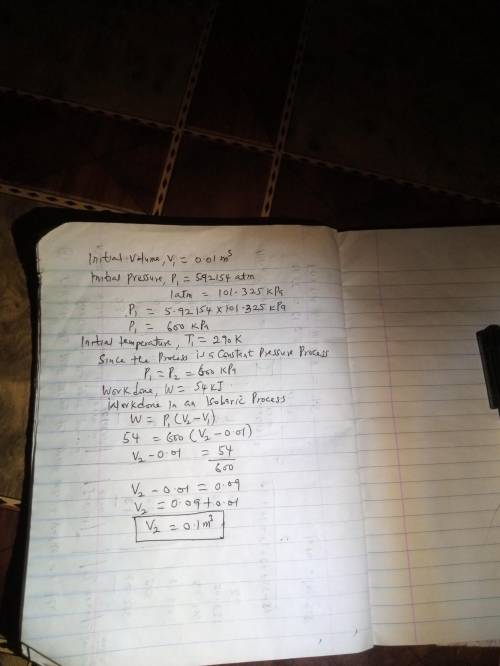
Engineering, 23.04.2020 03:05 brendonyuvan
A 0.01 m3 piston and cylinder contains an ideal gas at 5.92154 atm, 290 K . A constant pressure process produces 54 kJ of work on the surroundings. What is the final volume of the gas?

Answers: 2
Another question on Engineering

Engineering, 04.07.2019 18:10
What difference(s) did you notice using a pneumatic circuit over hydraulic circuit.explain why the pneumatic piston stumbles when it hits an obstacle.
Answers: 2

Engineering, 04.07.2019 18:10
Refrigerant 134a enters an insulated compressor operating at steady state as saturated vapor at -26°c with a volumetric flow rate of 0.18 m3/s. refrigerant exits at 9 bar, 70°c. changes in kinetic and potential energy from inlet to exit can be ignored. determine the volumetric flow rate at the exit, in m3/s, and the compressor power, in kw.
Answers: 1

Engineering, 04.07.2019 18:10
Ariver flows from north to south at 8 km/h. a boat is to cross this river from west to east at a speed of 20 km/h (speed of the boat with respect to the earth/ground). at what angle (in degrees) must the boat be pointed upstream such that it will proceed directly across the river (hint: find the speed of the boat with respect to water/river)? a 288 b. 21.8 c. 326 d. 30.2
Answers: 3

Engineering, 04.07.2019 18:10
A-mn has a cubic structure with a0 0.8931 nm and a density of 7.47 g/cm3. b-mn has a different cubic structure, with a0 0.6326 nm and a density of 7.26 g/cm3. the atomic weight of manganese is 54.938 g/mol and the atomic radius is 0.112 nm. determine the percent volume change that would occur if a-mn transforms to b-mn.
Answers: 2
You know the right answer?
A 0.01 m3 piston and cylinder contains an ideal gas at 5.92154 atm, 290 K . A constant pressure proc...
Questions







History, 03.08.2020 14:01



Biology, 03.08.2020 14:01




Mathematics, 03.08.2020 14:01





Biology, 03.08.2020 14:01





